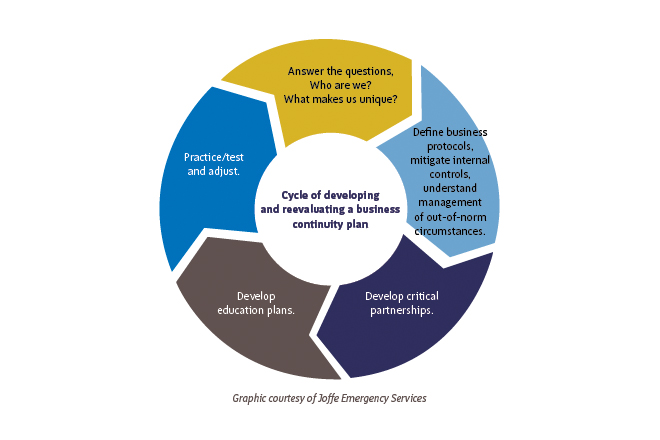Article by Chris Joffe, Joffe Emergency Services
Most independent schools have an emergency response plan and crisis communications plan, but significantly fewer have a business continuity plan outlining how they will continue operating after a natural disaster or on-campus crime. Many of those that have started such a plan not completed it.
We worked with one school that had to close for the first four days of the school year due to daily credible bomb threats.
Developing a solid business continuity plan can pay off. We worked with one school that had to close for the first four days of the school year due to daily credible bomb threats. By the end of the week, the school had set up age-appropriate rooms in a hotel conference space for some of the younger students while it continued to work out safety and security on campus.
Start the planning process with the head of school and the business office. Ask, “What makes our school unique?” and build a plan that enables key functions — whether they include athletics programs or academics or just business and operational activities — to continue. Don’t be tempted to outsource this task to the IT team; technology is just one essential element of a good recovery plan.
We recommend breaking down a business continuity plan into three sections: people, space and the business office.
People
How would your school function if a number of and/or staff chose to leave their jobs rather than return after a campus emergency? This happens; younger workers may be tempted to move closer to family, where they feel safer. Consider setting up relationships in advance with organizations like Teachers on Reserve or other substitute organizations. We also recommend using a separate app for communicating with students, families, faculty staff during and after emergencies. Regardless of whether normal email and/or phone systems are working, this alerts parents that the notice is more urgent than usual.
Space
Finding usable space to create connections and warmth in the aftermath of a disaster can be critical. Even a small fire can make parts or all of a school inaccessible. Lockdowns, too, can necessitate a campus shutdown of several days if the school becomes the site of a crime. For most schools, fostering community is one of the most important functions, even important than providing education in some cases. We recommend developing a memorandum of understanding with a local school, hotel, conference or convention center, or other suitable space to ensure you have a place to function for days, months or even years before campus reopens.
Business Office
Work with secure cloud-based systems to build in redundancies and avoid a single point of failure. In the aftermath of the northern California wildfires late last year, we worked with several CFOs who resorted to operating out of hotel rooms, with no access to the campus computer through which they normally ran payroll. Simply taking the steps to pay faculty and staff were laborious and prone to error. Likewise, prepare for the possible hack of key business office software. What would you do if such programs went down for a day or even weeks?
We understand that it can be easy for business officers to push the development of a business continuity plan to the back burner. To ensure it happens, try setting goals for certain milestones. For example, schedule a meeting to assess priorities by spring break, develop MoUs before school reopens, etc.
Once you’ve developed your plan, revisit it at least once a year and “tabletop” it, by talking through how the school would respond to a particular disaster. Risk management firms like ours can work with schools to run through different scenarios. We like to do as well as “fun” scenarios, such as a zombie apocalypse, to get people thinking outside the box.



